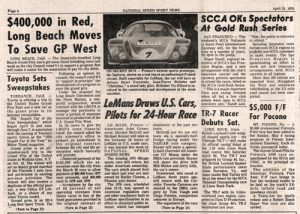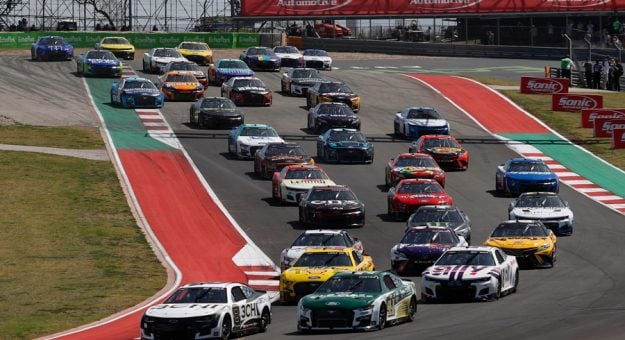Bill France’s idea could be seen as far-fetched.
Taking stock cars built for American short tracks and superspeedways and bringing them to the 1976 running of the 24 Hours of Le Mans was certainly out of the ordinary, as these cars went against the grain of everything that raced at Le Mans.
Instead of sleek prototypes like the race-winning Porsche 936 and the GTP class-winning Inaltéra, NASCAR sent a Dodge Charger and a Ford Torino across the Atlantic to compete, with modifications made for the circuit and for the regulations that the Automobile Club de l’Ouest used to organize the race.
The Charger blew an engine on the second lap after running on fuel it wasn’t designed for, while the Torino fell by the wayside during the night with transmission failure.
The experiment was brief, and while lap times were among the slowest in the field, the idea remained in the background.
Could NASCAR ever return to Le Mans?
“I remember when Dick Brooks came back, he was one of the drivers, I asked him what his thoughts were on it,” said NASCAR CEO Jim France. “He said, ‘No. 1, the fans love the car. No. 2, it was a fantastic experience, and No. 3, it was a hell of a challenge.’ You can look at the folks at this table, they all like big challenges, good experiences and really we want to expose Pierre (Fillon, president of the ACO)’s great fan base to our NASCAR cars and drivers.”

Next year, Jim France is attempting to lead NASCAR back to France as IMSA and its parent company, NASCAR, announced a plan to enter a Next Gen stock car in that year’s 24 Hours of Le Mans.
Their entry will be billed as the Garage 56 entry for testing new technologies, contingent on approval from the ACO.
NASCAR is working with the ACO to modify a Next Gen stock car so the car can compete at an equal performance level of the GT classes despite being scored in a class all on its own.
If the ACO is satisfied with the modifications, the car will appear on the entry list under the Hendrick Motorsports banner for the 91st edition of the 24 Hours of Le Mans.
This announcement came during the Mobil 1 Twelve Hours of Sebring weekend with representatives from IMSA, NASCAR, General Motors, the ACO, Goodyear Tire and Rubber Co., and Hendrick Motorsports present.
While France spoke at the beginning of the announcement about Brooks’ recollection, fellow panel members were beaming at the prospect of taking an American-style race car to Le Mans.
Getting to Le Mans will require clearing major logistical hurdles. Rick Hendrick’s organization will work with NASCAR to develop and test the car before sending it and all of the required racing equipment and personnel overseas.
Everything will need to be at the Circuit de la Sarthe for the test day traditionally held a week or two prior to the race. It might be time to dust off the old overseas traveling checklists, as the last time Hendrick Motorsports sent a car and its equipment overseas to race was in 1998.
That year, NASCAR had an exhibition race at Twin Ring Motegi in Japan where Jeff Gordon finished second to Mike Skinner.
Chevrolet’s personnel will assist Hendrick Motorsports in getting the team prepared to race in France.
General Motors has eight class wins at Le Mans with subsidiary Pratt & Miller and its Corvette Racing team, so Hendrick Motorsports will have experienced people backing them every step of the way.
“That’s one of the other reasons that there’s been the opportunity to work with Chevrolet as the winningest brand in NASCAR, because they also have the sports car experience,” said IMSA President John Doonan, who is a technical leader of the project. “So from a logistics standpoint, from an equipment standpoint, from a race strategy and how to approach the race from a reliability standpoint with the cars, and the things that we will do for endurance racing, having the experience that Corvette Racing has demonstrated and learned over the years is critical to the project being able to go over there and succeed.”
The Next Gen stock car will race on Goodyear tires. Goodyear has a lot of recent experience at Le Mans as they are the exclusive tire supplier for the LMP2 class in the World Endurance Championship.
While NASCAR does race on Goodyear tires across all three national touring series, the name on the tires will be one of the few similarities the Le Mans specification car will share with the machines that race stateside.
The Next Gen stock car will require many modifications to compete at Le Mans. The headlight and taillight decals will need to be replaced with actual working lights, especially since the majority of the circuit is not lit at night.
The braking system will need some adjustments since Le Mans has several heavy braking zones and brake pad changes are commonplace in the Grand Prix of Endurance, so a quick-change system would be ideal to have.
Something that might not change, however, are the sides of the car.
NASCAR hasn’t had doors on their race cars since the early 1960s and cars racing at Le Mans have two doors. While conventional wisdom suggests that NASCAR would modify the Next Gen chassis to allow for doors, the option of keeping the center portion of the car as-is and having drivers climb in and out through the left-side window remains.
“NASCAR has elements of what I would call NASCAR DNA,” Doonan said. “Clearly, we’re taking a NASCAR Next Gen car to Le Mans to compete in the 24-hour race and we want to retain as much as of that DNA as we can.”
NASCAR does have a workaround as the FIA’s (world motorsports governing body) technical regulations for Le Mans state that the door window on the driver’s side “may be replaced with a net.”
Technically speaking, there is no requirement for the cars to even have doors at all, but the rules also state that it must be possible to open the doors from the inside and the outside.
All of the mechanical aspects of the car will require strengthening to compete for 24 hours. The engine will more than likely need some detuning, although if a hybrid system is brought to the car a complete redesign might be necessary.
To look at a reliability benchmark, the car will need to endure a race distance nearly five times the length of NASCAR’s longest race — the Coca-Cola 600 at Charlotte Motor Speedway.
Being at the finish after 24 hours is the big goal and Doonan is working with the partners of this project to make that result achievable.
“There’s no question finishing 24 hours is in many ways a victory in and of itself for anybody competing because of the challenges and the other variables that can play a role in a 24-hour endurance race,” Doonan said. “There’s obviously rain and ambient temperature and a lot of factors. So finishing is No. 1, and I think ultimately, that’s probably the biggest trophy anyone can wish for by taking the car there and competing for 24 hours. And Jim France’s words at the press conference, you know, ‘Finish, and not finish last.’”
As for drivers, there will be professionally rated drivers behind the wheel of the car, holding a Platinum or Gold designation by the FIA. Drivers could be from within the Hendrick Motorsports organization or they could be from another form of racing entirely, but those decisions have yet to be made.
“That’s the beauty of things like simulators,” Doonan said. “We can put a variety of folks in simulators to give them the experience of driving the Next Gen car at Le Mans and on the Le Mans circuit. And I think Garage 56 provides you some versatility when it comes to driver lineups, but it’s our intent to bring professional drivers to drive the Next Gen car at Le Mans in 2023 as part of Garage 56.”
Following Le Mans, NASCAR and IMSA will evaluate the Next Gen car’s performance compared to their pre-race goals.
If the car meets or exceeds expectations, NASCAR and IMSA could work the Next Gen car into IMSA competition, fulfilling the project NASCAR had in the 1980s with the L-R cars.
Back then, NASCAR developed special cars that were meant for road racing and were much lighter than conventional Cup Series cars of that time, but plans to race those cars fizzled out as the NASCAR schedule evolved during the late 1980s.
The French citizens responded very positively when Corvette Racing came to Le Mans in the early 2000s. They will have another chance to see some Americana when NASCAR returns to Le Mans.
